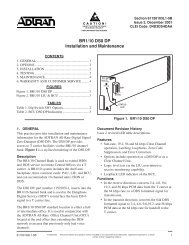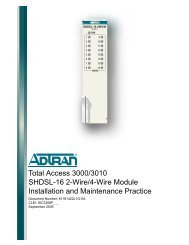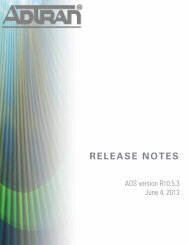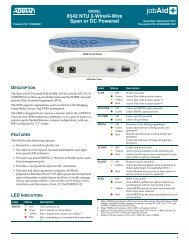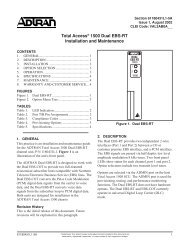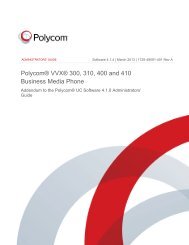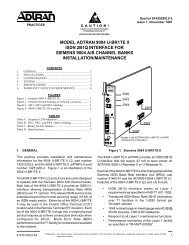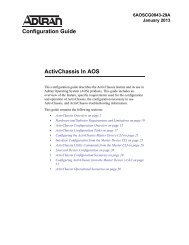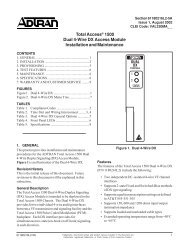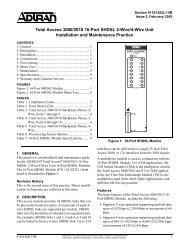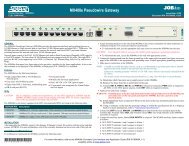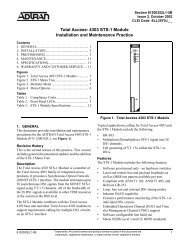View - ADTRAN Support Community
View - ADTRAN Support Community
View - ADTRAN Support Community
You also want an ePaper? Increase the reach of your titles
YUMPU automatically turns print PDFs into web optimized ePapers that Google loves.
Additional BGP Configuration<br />
Refer to Example 6 on page 46 for a detailed BGP configuration example where route maps<br />
are applied inbound and outbound to different BGP neighbors.<br />
Router ID<br />
The BGP interface identifies itself to neighbors with its router ID. Often this ID is the IPv4 address of the<br />
logical interface that connects to each neighbor. However, the ID can also be the address of a loopback<br />
interface used as the update source. A loopback interface that is the update source for BGP ensures that a<br />
BGP session stays open even if one connection goes down. The following command specifies the router<br />
ID:<br />
(config-bgp)#bgp router-id <br />
Designates the IPv4 address this router should use as its BGP router ID. IPv4 addresses<br />
should be expressed in dotted decimal notation (for example, 10.10.10.1) or as a prefix length (for<br />
example, /24).<br />
If no IPv4 address is configured at BGP startup, it uses the highest IPv4 address configured<br />
on a loopback interface. If no loopback interfaces are configured, it uses the highest IPv4<br />
address configured on any interface that is active. If the specified router ID is changed,<br />
existing sessions with BGP neighbors are reset.<br />
Soft Reconfiguration Inbound<br />
Soft reconfiguration enables the router to store all updates from a neighbor in case the inbound policy is<br />
changed. The command is issued in BGP Neighbor Configuration mode and allows a network<br />
administrator to reconfigure BGP policies without clearing active BGP sessions. Administrators can then<br />
institute new policies at any time without forcing the neighbors to reestablish their connection and possibly<br />
disrupt traffic.<br />
BGP updates are stored prior to filtering; thus, allowing the clear ip bgp soft command to be used in the<br />
absence of route refresh (RFC 2918) capability. The unfiltered table is used when an inbound policy is<br />
changed; allowing the router to implement policy changes immediately based on the stored table instead of<br />
having to wait on a new table to be built after a hard reset. A soft reset is beneficial over a hard reset<br />
because it allows policy updates without disrupting network traffic flow. A hard reset terminates the<br />
existing BGP session, effectively removing all routes learned from a neighbor. A new session is then<br />
created and all of the routes must be relearned. Because this process takes place with a hard reset, a<br />
network outage can potentiality occur until the BGP database and route table have been rebuilt.<br />
Refer to Clear IP BGP on page 74 for more information on this command.<br />
Use the soft-reconfiguration inbound command to enable the AOS device to store BGP updates for the<br />
specified neighbor:<br />
(config-bgp-neighbor)#soft-reconfiguration inbound<br />
61200860L1-29.4E Copyright © 2012 <strong>ADTRAN</strong>, Inc. 31




